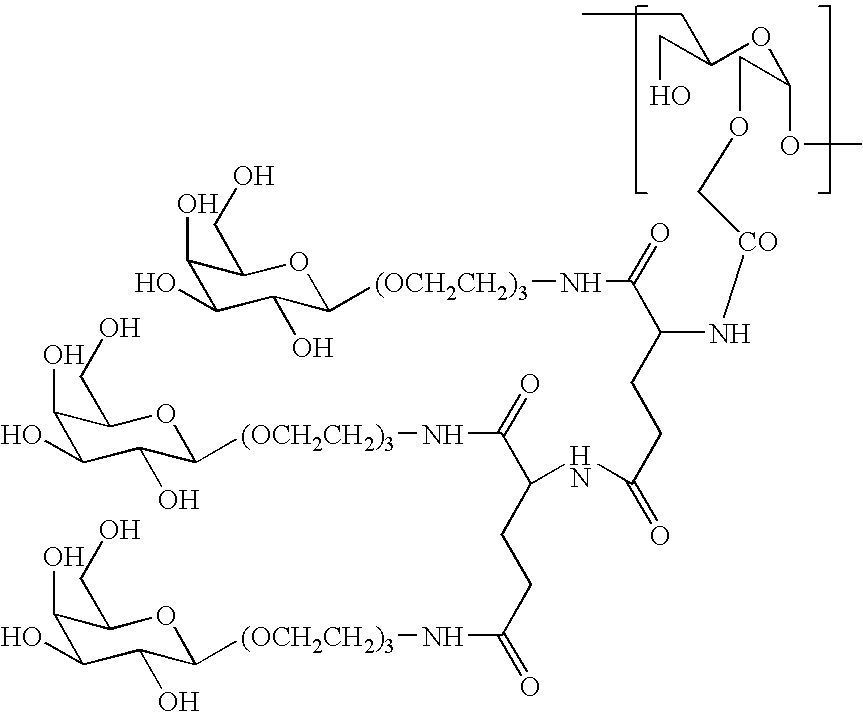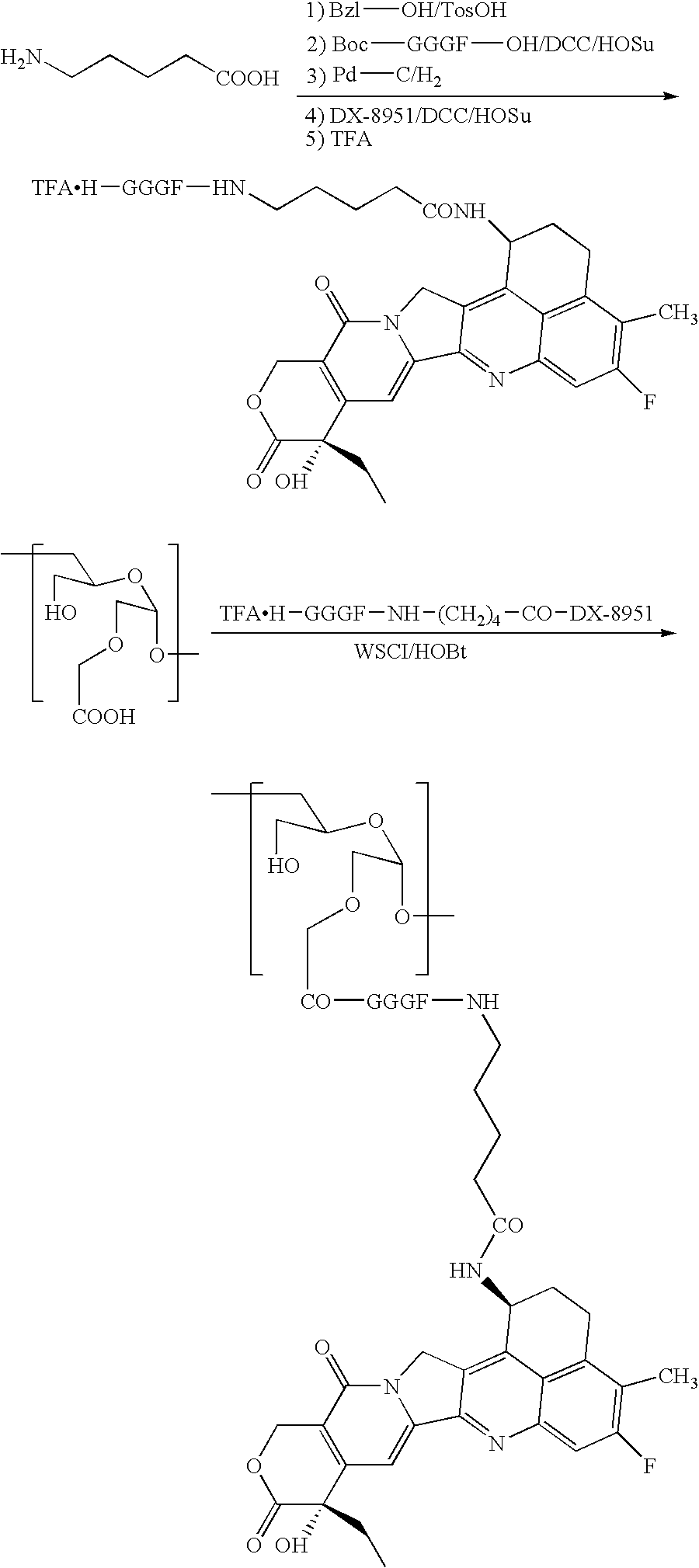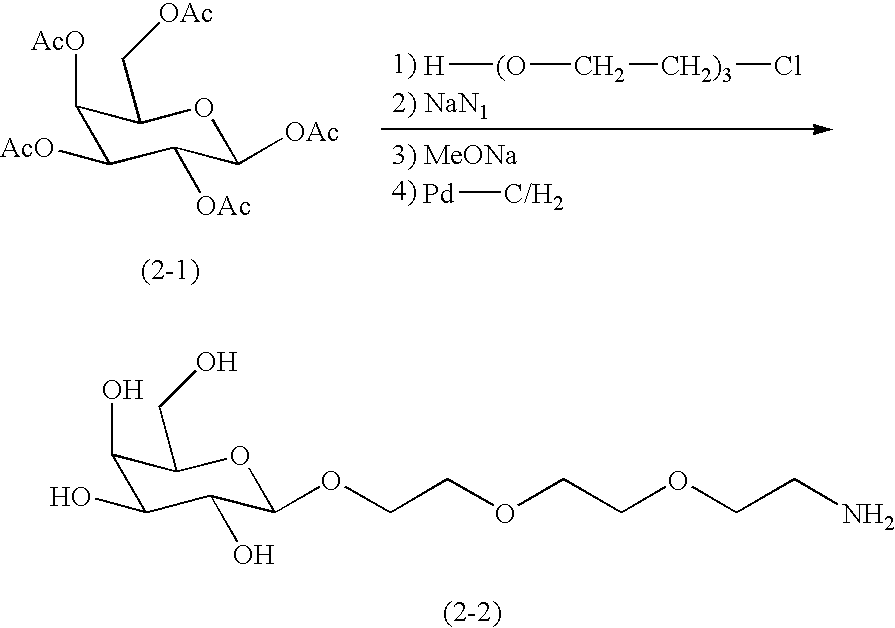DDS compound and method for measurement thereof
a compound and dds technology, applied in the field of dds compound, can solve the problems of emesis, pyrexia, alopecia at an extremely high rate, and blood concentrations that are sometimes too low to distribute to tumorous sites sufficiently, and achieve excellent liver selectivity and organ selectivity. high
- Summary
- Abstract
- Description
- Claims
- Application Information
AI Technical Summary
Benefits of technology
Problems solved by technology
Method used
Image
Examples
example 1
[0084]A DDS compound (Compound 1) in which a carboxymethyldextran polyalcohol (occasionally abbreviated as “CM-Dex-PA” or “CM-dextran polyalcohol” hereinafter in the examples) as a polymer carrier and an antineoplastic agent ((1S,9S)-1-amino-9-ethyl-5-fluoro-2,3-dihydro-9-hydroxy-4-methyl-1H,12H-benzo[de]-pyrano[3′,4′:6,7]indolizino[1,2-b]quinoline-10,13(9H,15H)-dione disclosed in claim 2 of Japanese Patent Unexamined Publication (KOKAI) (Hei) No. 6-87746 / 1994 (abbreviated as “DX-8951” in hereinafter in the examples) were bound by means of a tetrapeptide spacer represented as -Gly-Gly-Phe-Gly- (SEQ ID NO. 1) (the oligopeptide is shown as the sequence from their N-terminals, and others are shown in the same manner hereinafter in the examples) was produced according to the method described in Example 15 of International Publication WO97 / 46260. As the CM-Dex-PA, that having an average molecular weight of 228K, and a carboxymethylation degree (degree of substitution with carboxymethyl g...
example 2
[0086]
[0087]A DDS compound (Compound 2) in which CM-Dex-PA and DX-8951 were bound by means of a spacer represented by -Gly-Gly-Gly-Phe-NH—(CH2)4—CO— (SEQ ID NO. 8) was prepared as follows. 5-Aminopentanoic acid (1.0 g), p-toluenesulfonic acid (1.95 g), and benzyl alcohol (5 ml) were allowed to react in toluene (50 ml) at 140° C. for 5 hours while removing the produced water by using a Dean-Stark apparatus. The reaction mixture was concentrated, and the resulting residue was solidified by adding ether. The solid obtained was filtrated, washed with ether, and dried to obtain 2.9 g of tosylic acid salt of 5-aminopentanoic acid benzyl ester.
[0088]Boc-Gly-Gly-Gly-Phe-OH (575 mg) (SEQ ID NO. 8), HOSu (182 mg), and DCC (326 mg) were dissolved in DMF (20 ml), and the mixture was stirred for 30 minutes. The solution was added with a solution of p-toluenesulfonic acid salt of 5-aminopentanoic acid benzyl ester (500 mg) and triethylamine (0.184 ml) dissolved in DMF (10 ml), and the mixture was...
example 3
[0093]The DX-8951 content in the DDS compound prepared in Example 1 (Compound 1) was measured by using (1) subtilisin A (0.1 M Tris-HCl, pH 9.0), (2) α-chymotrypsin (0.1 M Tris-HCl, pH 8.0), and (3) thermolysin (0.1 M Tris-HCl / 1 mM CaCl2, pH 9.0). 10 μl of a solution of Compound 1 prepared as 400 μg / ml was added to 180 μl of a buffer for each enzyme (final concentration; 20 μg / ml). To this mixture, 10 μl of each enzyme prepared as 100 mg / ml in each buffer was added (final concentration; 5 mg / ml), and the mixture was allowed to react for 3 hours at 40° C. After the reaction, 200 μl of 0.5 N HCl solution containing 50% of acetonitrile was added to the mixture, and 10 μl of the mixture was analyzed by HPLC. For the HPLC analysis, a Symmetry C18 (4.6×250 mm) column was used, and elution was performed with 0.1 M AcONa buffer (pH 5.0) containing 31% of organic solvent (acetonitrile:methanoly=2:1). The hydrolysate was measured by fluorescent spectroscopy (Ex. 375 nm and Em. 445 nm), and th...
PUM
| Property | Measurement | Unit |
|---|---|---|
| temperature | aaaaa | aaaaa |
| pH | aaaaa | aaaaa |
| pH | aaaaa | aaaaa |
Abstract
Description
Claims
Application Information
 Login to View More
Login to View More - R&D
- Intellectual Property
- Life Sciences
- Materials
- Tech Scout
- Unparalleled Data Quality
- Higher Quality Content
- 60% Fewer Hallucinations
Browse by: Latest US Patents, China's latest patents, Technical Efficacy Thesaurus, Application Domain, Technology Topic, Popular Technical Reports.
© 2025 PatSnap. All rights reserved.Legal|Privacy policy|Modern Slavery Act Transparency Statement|Sitemap|About US| Contact US: help@patsnap.com



